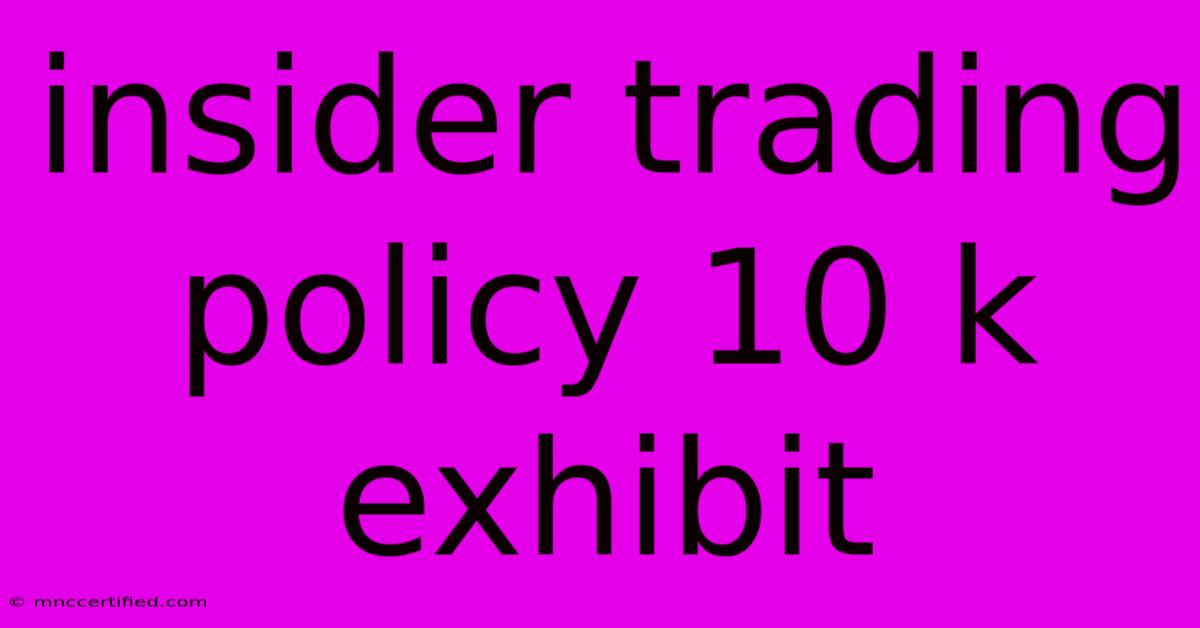Insider Trading Policy 10 K Exhibit

Table of Contents
Understanding Insider Trading Policy in 10-K Exhibits: A Guide for Investors
For investors, navigating the complexities of corporate disclosures can feel overwhelming. The 10-K report, filed annually by publicly traded companies, is a crucial source of information, including insights into their insider trading policies. Understanding how these policies are presented and what they mean for your investment decisions is paramount.
What is Insider Trading Policy?
Insider trading policy outlines the rules and procedures that govern the buying and selling of a company's securities by its insiders. These insiders include:
- Officers and directors: Executives who hold key positions within the company.
- Employees: Individuals who have access to confidential information about the company's operations and financial performance.
- Shareholders: Individuals or entities who own a significant stake in the company.
Insider trading policies are designed to:
- Prevent unfair advantage: Ensure that insiders do not use privileged information to profit at the expense of other investors.
- Maintain market integrity: Promote fair and transparent trading practices.
- Protect the company's reputation: Avoid legal and ethical repercussions associated with insider trading.
Finding Insider Trading Policy in a 10-K
While the specific location of the insider trading policy may vary between companies, it is typically found within the "Management's Discussion and Analysis of Financial Condition and Results of Operations" (MD&A) section of the 10-K report.
Here's what to look for:
- "Code of Ethics": Companies often include their code of ethics, which may address insider trading practices and expectations for insider behavior.
- "Corporate Governance": This section often discusses the company's approach to corporate governance, which may include details on insider trading policies and procedures.
- "Risk Factors": Companies may highlight insider trading as a potential risk factor, outlining their strategies to mitigate this risk.
Key Elements of Insider Trading Policies
While specifics can differ, most insider trading policies address:
- Definition of "insider": Clearly defining who is subject to the policy.
- Prohibited activities: Specifying actions that are considered insider trading, such as trading on non-public information or tipping others.
- Reporting and disclosure requirements: Outlining procedures for reporting insider transactions and disclosing material information.
- Enforcement mechanisms: Describing how the policy is enforced and the consequences for violations.
Why This Matters to You
Understanding a company's insider trading policy provides valuable insights into:
- Corporate governance: It reflects the company's commitment to ethical and responsible conduct.
- Transparency and accountability: It demonstrates the company's efforts to maintain fair and transparent markets.
- Investor protection: It helps ensure that all investors have equal access to information.
Utilizing Insider Trading Policy for Investment Decisions
While a strong insider trading policy is a positive sign, it doesn't guarantee a company's financial success. However, it can be a factor to consider when evaluating investment opportunities.
- Compare policies across companies: Look for consistency and strength in their policies to gauge their commitment to ethical practices.
- Monitor insider transactions: Analyze insider trading activity and compare it to the company's policy and overall financial performance.
- Consider the company's track record: Evaluate previous instances of insider trading or related controversies.
Additional Resources
- Securities and Exchange Commission (SEC): Provides comprehensive information on insider trading laws and regulations.
- Financial Industry Regulatory Authority (FINRA): Offers resources for investors on understanding insider trading and its implications.
Conclusion
Understanding the insider trading policies outlined in 10-K reports is essential for investors seeking to make informed decisions. By carefully reviewing these policies and their implications, you can better assess the risk and potential of your investments.
Remember, insider trading policies are just one aspect of a company's overall performance and investor relations. It's crucial to conduct thorough research and consider all relevant factors before making any investment decisions.

Thank you for visiting our website wich cover about Insider Trading Policy 10 K Exhibit. We hope the information provided has been useful to you. Feel free to contact us if you have any questions or need further assistance. See you next time and dont miss to bookmark.
Featured Posts
-
Thursday Night Football Eagles Channel
Nov 15, 2024
-
Snow Maps England Covered By Arctic Blast
Nov 15, 2024
-
Nations League Greece Vs England Live Stream
Nov 15, 2024
-
Vaccine Sceptic Rfk Jr Picked For Health Role
Nov 15, 2024
-
Scottish Brands Swift Dress A Year Of Sellouts
Nov 15, 2024